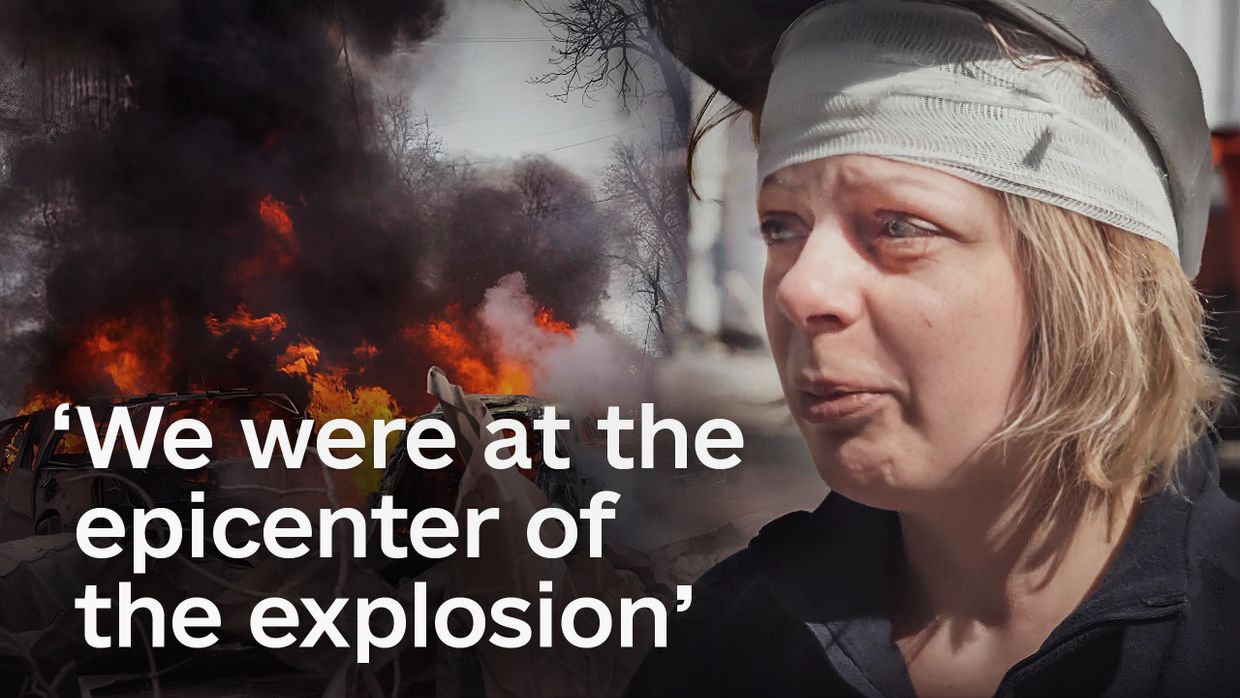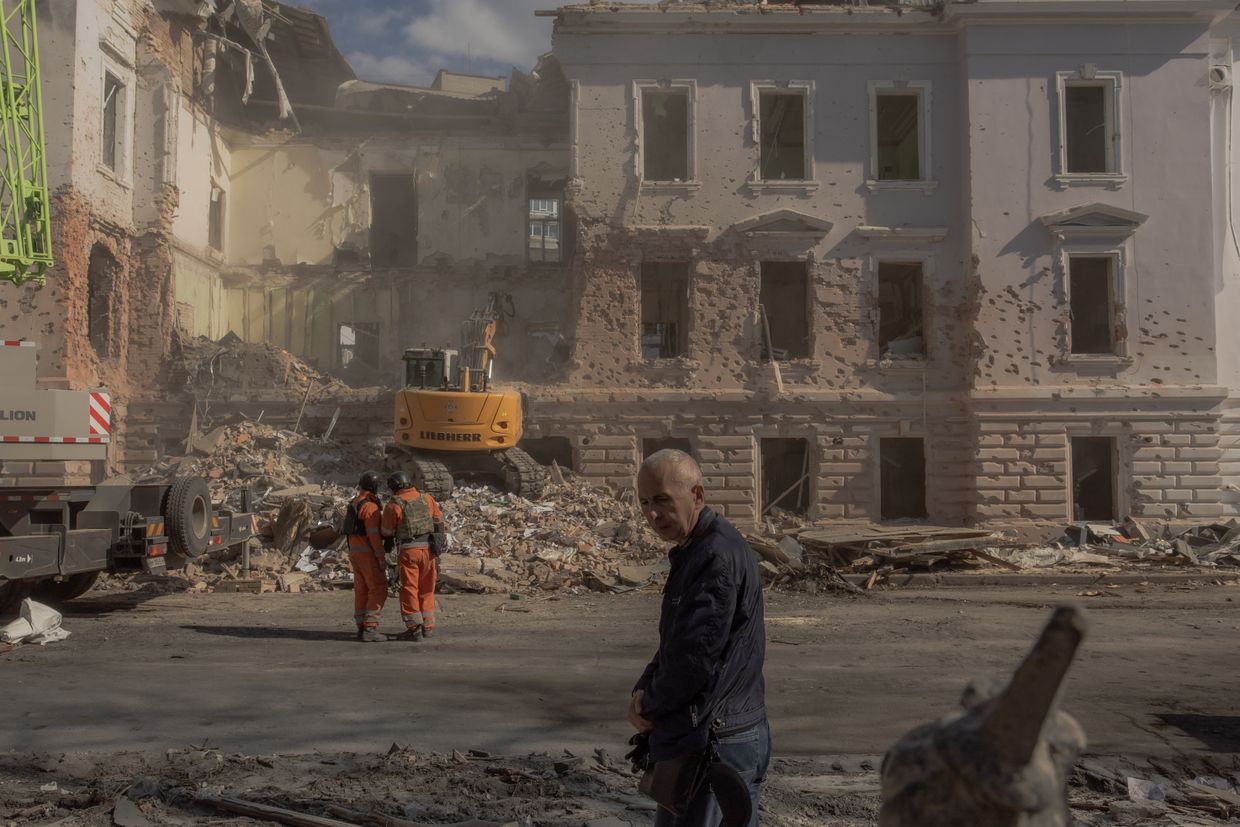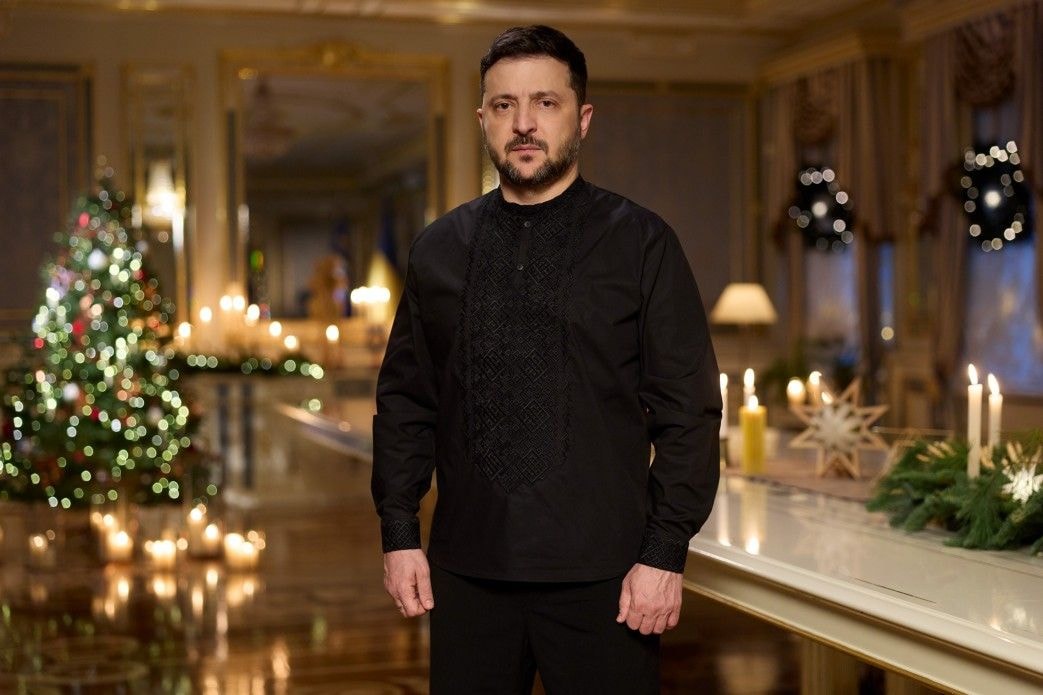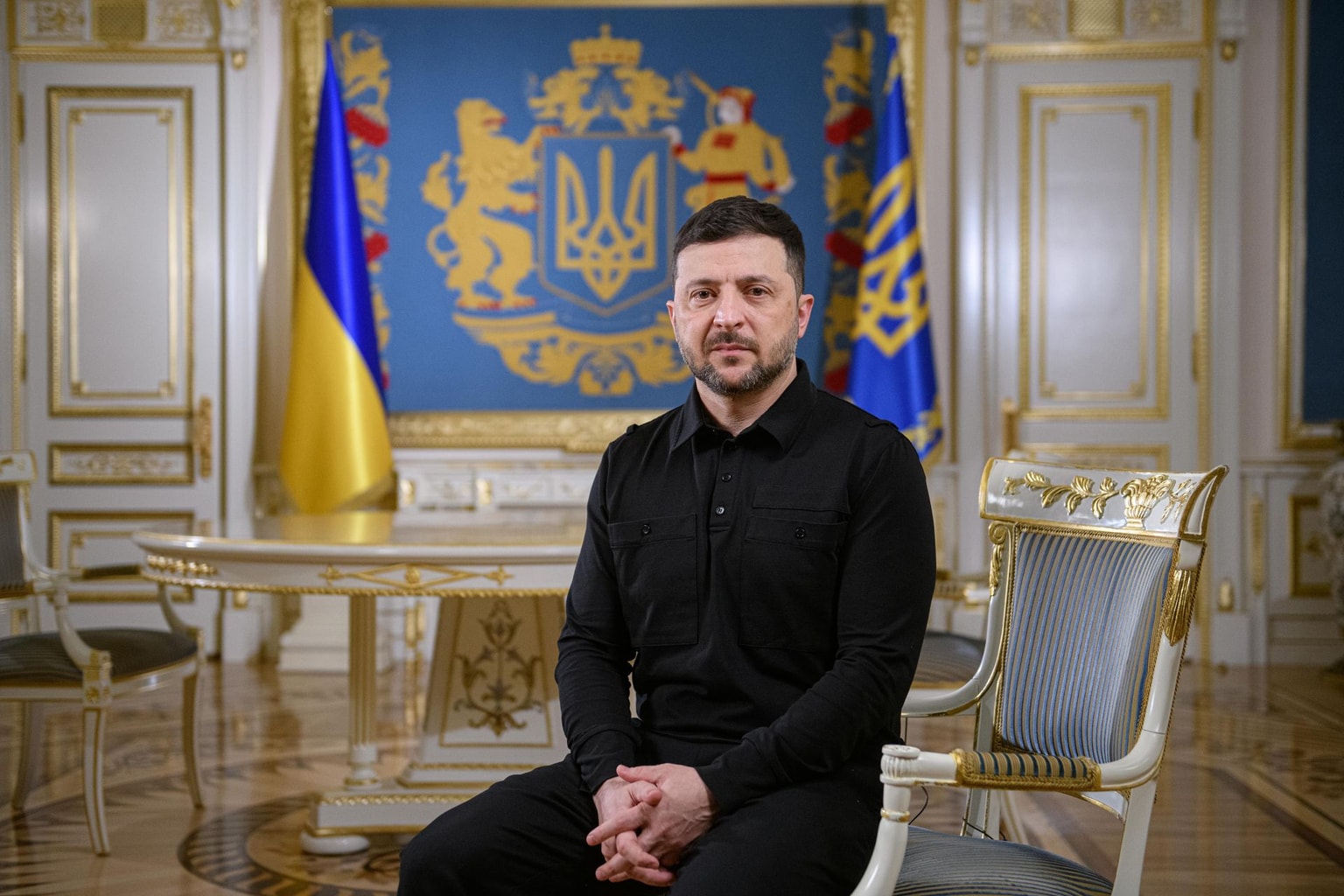
From hospitals to malls, the deadliest Russian strikes on civilians in Ukraine so far
Russia’s deadliest attacks on civilians since the start of the full-scale invasion.
Firefighters stand in front of a building hit by a Russian missile on Jan. 14, 2023, in Dnipro, Ukraine. At least 46 people were killed. (Gaelle Girbes/Getty Images)
After Russia launched a missile strike at the city of Sumy on Palm Sunday — killing 35 civilians, including children, and injuring over 100 others — U.S. President Donald Trump wrote off the attack as a “mistake.”
"I think it was terrible, and I was told they made a mistake, but I think it's a horrible thing, Trump said when asked about the Sumy attack.
But Russia’s missile strike on Sumy is just one in a series of deadly attacks on civilian areas since the start of its full-scale invasion against Ukraine.
Moscow’s attacks have repeatedly targeted residential buildings, railway stations, city centers, hospitals, evacuation convoys, and people’s gatherings — including a wake service — inflicting high civilian casualties with each one.
“(Launching) a missile with cluster munitions is something Russians do to kill as many civilians as possible,” said Presidential Office Head Andriy Yermak, referring to one of the missiles used in the Sumy attack, which contained fragments that exploded mid-air to inflict maximum damage to the surrounding area.
Russia’s latest deadly attack also comes amid ceasefire negotiations and peace talks brokered by the U.S. While Kyiv agreed to a full 30-day ceasefire on March 11, Moscow has so far refused to do so. Sumy residents told the Kyiv Independent on April 14 that attacks on the city have only gotten worse in recent months.
According to the latest U.N. statistics, over 12,340 civilian deaths have been recorded in Ukraine since Russia launched its full-scale invasion in February 2022, though the true figure is likely far higher.
Below is a list of Russia’s deadliest attacks on civilians on record since the start of the full-scale invasion. The list reveals a pattern of targeted attacks at civilian centers, with little or no evidence to suggest the strikes were failed attempts at hitting Ukrainian military targets.
Kharkiv administration building
With Russia’s advance in March 2022, shortly after the start of the full-scale invasion, Moscow launched several attacks with mass civilian casualties in regional centers along Ukraine’s northern borders with Russia and Belarus.
Around 8 a.m. on March 1, Russia hit the Kharkiv Regional State Administration building on the city’s main square with two "Kalibr" cruise missiles.
The first strike on the square was captured on video, showing several civilian cars disappearing in an explosion.

The second missile destroyed the right wing of the building less than 10 minutes later, when rescuers arrived on the scene — in what would become a model for numerous subsequent ‘double-tap’ attacks, designed to hit the first responders arriving on the scene of an attack soon after the first strike.
Kharkiv Oblast Governor Oleh Syniehubov later shared in 2023 that the final death toll in the Kharkiv administration building attack was 44 people.
Residential area in Chernihiv
On March 3, 2022, Russia bombed a square in a residential area of the city of Chernihiv, a regional center that lies between Russia and Ukraine’s capital Kyiv, killing 47 people.
“This was a merciless, indiscriminate attack on people as they went about their daily business in their homes, streets and shops,” said Joanne Mariner, Amnesty International’s crisis response director.
After an investigation, Amnesty International was not able to identify a legitimate military target in the vicinity of the strike. The majority of victims were queuing for food when the missiles struck, the investigation found.

Homes in Sumy
Overnight on March 7, 2022, Russian forces launched three bombs on homes in Sumy, a northern regional center that borders Russia’s Kursk Oblast, Bryansk, and Belgorod oblasts.
The strikes took the lives of 22 people, including three children, according to local officials. One of them was Artem Pryimenko, Ukraine’s 15-year-old Sambo champion, killed with his two younger brothers and their entire family on the eve of their planned evacuation from the city.

Kramatorsk railway station
The city of Kramatorsk is a critical logistics hub in Ukraine’s eastern Donetsk Oblast — one of the regions Russia has attempted to fully capture since the start of the full-scale invasion and where the war’s heaviest battles have been fought.
On Apr. 8, 2022, when over a thousand Kramatorsk residents, mainly women and children, were queuing for an evacuation train, Russia launched two Tochka-U ballistic missiles at the Kramatorsk railway station.
It is the deadliest single attack on civilians in Ukraine on record since the start of the full-scale invasion, killing 63 people, including nine children. Russia initially claimed it had hit a military target, but then denied its responsibility after international reports of killed civilians.
"There was so much blood, dead people everywhere," 19-year-old Anastasiia Shestopal, who lost her leg in the attack, told the Kyiv Independent.


Shopping mall in Kremenchuk
Kremenchuk was considered a relatively safe city due to being located in Ukraine’s center far from the front — until a Russian strike on a shopping mall in the city center on June 27, 2022. The missile strike destroyed the mall, killing 21 people.
The Kredmash road machinery plant was located just behind the mall — potentially the target of Russia’s two Kh-22 anti-ship cruise missiles launched that day at the area.
Despite the high civilian death toll, Russia continues to strike Ukrainian cities with these missiles, which are outdated and “notoriously inaccurate” when fired at ground targets in urban areas, according to British intelligence.


Five-story residential buildings in Chasiv Yar
The town of Chasiv Yar in Donetsk Oblast saw one of the deadliest Russian attacks on civilians in 2022, before the devastation of the battle for its neighbor Bakhmut and a bloody fight on its own outskirts.
Russian troops hit two five-story apartment buildings in Chasiv Yar around 9 p.m. on Saturday, July 9, with an Uragan multiple rocket launcher, built to inflict maximum damage to wide areas with 16 rockets fired over twenty seconds.
A rescue operation to clear the two sections of the apartments that collapsed into piles of rubble in the attack took five days.
Nine people were found alive, while two soldiers and 46 civilians were killed, including one child. Russia falsely claimed to have killed over 300 soldiers in the strike.
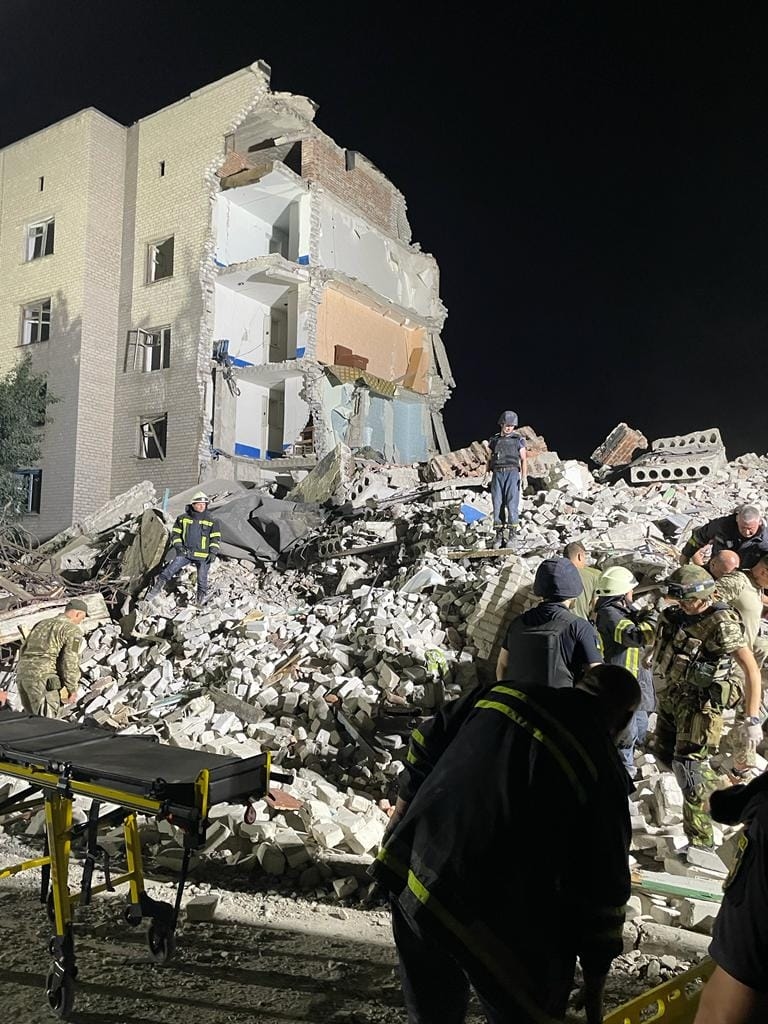
Vinnytsia city center
On July 14, 2022, as a conference took place in The Hague on holding Russia accountable for war crimes, Russia launched an attack at the city of Vinnytsia, another regional capital in central Ukraine far from the front lines.
Between 10 and 11 a.m. on a workday, five Russian Kalibr cruise missiles were fired at the city’s center. The Ukrainian military claimed to have shot some of them down, while others hit a medical center, offices, stores, and residential buildings, injuring over 200 people.
Liza Dmytriyeva, a 4-year-old Ukrainian girl with Down syndrome who was coming from a speech therapy session with her mother, was one of 28 civilians killed in the strike. It also claimed the lives of two other children.
Images of her bloodied stroller lying on the road next to her body went viral online as proof of Russia’s continued war crimes.

Kharkiv dormitories
Kharkiv, Ukraine’s second-largest city before the war and one of the closest to the border with Russia, endured a campaign of relentless months-long shelling before Ukrainian troops pushed Russian forces beyond the reach of artillery fire during the Kharkiv counteroffensive in 2022.
Weeks before the counteroffensive began, in the early morning and late evening of Aug. 17, Russia fired missiles at residential buildings in two districts.
The two strikes killed a combined 25 people, including one child. Many of the buildings’ residents were elderly.
Chaplyne railway station
Until a Russian attack on the village of Hroza in 2023, Chaplyne, a village of 4,000 people, was one of the smallest settlements where a single attack caused mass civilian casualties.
Russia launched five missiles on a Chaplyne railway hub on Ukraine’s Independence Day on Aug. 24, 2022.
One missile strike caused a residential building to collapse, burying a woman with two boys — an 11 and 13-year-old under the rubble. Locals were able to rescue the woman and the older boy alive. The other missiles hit the railway station and set wagons, buildings, and cars containing people on fire.
In total, 25 residents were killed in the attack, including two children.

Evacuation column of civilian cars near Zaporizhzhia
On Sept. 30, 2022, the day Russia announced the annexation of four only partially occupied Ukrainian oblasts after mock referendums where some residents were asked to vote at gunpoint, Russia launched fourteen S-300 missiles at the city of Zaporizhzhia.
Several missiles hit a convoy of about 60 civilian cars gathered on the city outskirts, waiting for a pre-planned trip to the Russian-occupied part of Zaporizhzhia Oblast to pick up relatives or deliver aid. Missile shrapnel killed 32 people in their cars and the surrounding area, including two children.
Residential building in Dnipro
On Jan. 14, 2023, Russia launched at least one Kh-22 missile — an almost six-ton, imprecise Soviet weapon designed to blow up warships — at the center of Ukraine’s fourth largest city, Dnipro.
The missile struck a nine-story apartment building, leveling one section to the ground in a split second and killing at least 46 people in the building and on the streets outside. The country was shocked by the brutality of the attack.

In videos from the attack’s aftermath shared online, screams and voices could be heard from under the rubble.
Six children were killed, including an 11-month-old, Mykyta, whose 27-year-old mother, Kateryna Zelenska, was rescued alive after 20 freezing hours under the rubble next to the bodies of her son and husband.
Although the rubble has been fully cleared since, eleven people are still considered missing, as the rescuers couldn’t find traces of their bodies.
Over a year later, in April 2024, Ukraine announced its first successful interception of two Kh-22 missiles.
Apartment building in Uman
Around 4:00 a.m. on Apr. 28, 2023, Russia launched over twenty Kh-101 long-range missiles on the central Ukrainian city of Uman, a yearly pilgrimage site of Hasidic jews located 200 miles away from the front line.
Two of the missiles destroyed a nine-story building. Ukrainian authorities said that the attack killed 23 civilians, including six children.
All the victims’ bodies were found and identified within a day of the attack, as dozens of Uman residents joined the rescuers in their search, and their blood relatives could submit DNA for identification at a specially organized collection point.
Wake service in the village of Hroza
A funeral reception for a soldier in the small village of Hroza in Kharkiv Oblast gathered around 60 local residents in a cafe near a playground on Oct. 5, 2023.
Based on a tip from two collaborators, Russia launched an Iskander ballistic missile at the cafe. Fifty-nine civilians — almost a fifth of the village’s population — were killed in the devastating strike, including 36 women, 22 men, and an 8-year-old boy.
The OHCHR said in a report that it “has reasonable grounds to believe that the reception was the intended target of an attack” by Russian forces.


At least 15 families in the village lost more than one family member in the attack. The fallen soldier’s family was killed as well. Half of the bodies were so mutilated that the DNA testing had to be used for identification, the report said.
“There were bodies and body parts everywhere. My daughter’s best friend was only identified by her manicure when they found her hand,” said Valentyna, a local civilian witness of the Hroza attack cited in the OHCHR’s report.
Playground in Kryvyi Rih
Since the Kramatorsk railway station attack, the most children killed in a single attack occurred in early April 2025, in the middle of the U.S. talks with Russia on a potential temporary ceasefire.
On Apr. 4, a Russian cluster ballistic missile hit a residential area with a playground, restaurant, and apartment buildings in Kryvyi Rih, a major industrial hub in Dnipropetrovsk Oblast and the hometown of President Volodymyr Zelensky.
The strike killed 20 people. Nine of them were children, some walking around with their parents, grandparents, or friends, and some just at home with their families.

Cluster munitions consist of many smaller detonating units. Ukraine’s Internal Affairs Ministry said on April 5 that the missile “was equipped with a cluster munition to maximize the number of people killed.”
Russia's Defense Ministry claimed that its “precise” strike had targeted a meeting of "unit commanders and Western instructors" in a restaurant, killing around 85 of them. But security footage shows that no military personnel were present there, according to the France 24 report.
Sumy city center on Palm Sunday
The latest in a long line of Russian attacks on civilians took place on the last Palm Sunday on April 13, when Russia launched a "double-tap" strike with Iskander-M missiles on Sumy’s city center in the late morning.
In total, 35 local residents were killed, among them two children. Over 100 people were injured. One of the strikes killed most of the passengers on a city bus. A 13-year-old boy pulled a few survivors out of the burning bus, his mom among them, after climbing out of the bus’s window.
Russia deployed cluster munitions in its second strike a few minutes after the first to inflict deliberate casualties on civilians in downtown Sumy, local authorities said.


All the people who died were pedestrians and civilians in their own vehicles or public transport. Some of them burned alive, while others bled out in their cars before rescuers could pull them out. Ukrainian orchestra musician Olena Kohut was among the victims.
Local authorities later confirmed rumors of a planned military ceremony on the day of the attack.
While European leaders have denounced the attack as a war crime and evidence of Russia's rejection of peace efforts, U.S. officials responded with condolences for Ukraine but no calls for increased pressure on Moscow.
Mariupol death toll
Some of the highest estimated civilian casualty tolls — in the currently Russian-occupied southern city of Mariupol — still remain undocumented.
Russia has systematically destroyed evidence and prevented international investigations into its strikes — including the bombing of the Mariupol drama theater on March 16, 2022, where between 300 to 600 people are estimated to have been killed while they were taking shelter.

Amnesty International called the strike “a clear war crime” by the Russian army in its interview-based and open source investigation.
Human Rights Watch put the total civilian death toll from Russia’s siege of Mariupol in 2022 at around 8,000 people, but added that true numbers are likely much higher.
International law
While the Kremlin routinely claims to hit military targets while striking civilian areas, in only one case with mass casualties did international observers find Ukrainian forces partially responsible for endangering civilians after taking firing positions in the Stara Krasnianka nursing home in Luhansk Oblast in 2022.
Due to heavily mined fields around the nursing home, the Ukrainian military said it was unable to evacuate the 86 people among the nursing home’s patients and staff. On March 11, 2022, Russians attacked the building with heavy weapons, killing at least 56 civilians.
But international law dictates that even the presence of soldiers doesn’t justify military action if there is a high risk of civilian casualties, Dmytro Koval, lawyer and director of the Ukrainian human rights organization Truth Hounds told the Kyiv Independent earlier as part of an investigation into Russia’s destruction of the Kakhovka dam in Kherson Oblast that took the lives of an estimated hundreds of civilians.
Note from the author:
Hello, this is Natalia Yermak, the author of this article. Thank you for reading it.
Russian attacks with huge civilian death tolls are on the rise in the past weeks as the U.S. administration cozies up to Russia. If you want to read more of our coverage on what could be swept under the rug in the ongoing peace talks, please consider joining the Kyiv Independent community. Your support fuels our work!

